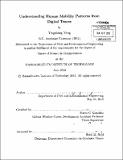| dc.contributor.advisor | Marta C. González. | en_US |
| dc.contributor.author | Yang, Yingxiang, S.M. Massachusetts Institute of Technology | en_US |
| dc.contributor.other | Massachusetts Institute of Technology. Department of Civil and Environmental Engineering. | en_US |
| dc.date.accessioned | 2013-12-06T20:50:30Z | |
| dc.date.available | 2013-12-06T20:50:30Z | |
| dc.date.issued | 2013 | en_US |
| dc.identifier.uri | http://hdl.handle.net/1721.1/82863 | |
| dc.description | Thesis (S.M. in Transportation)--Massachusetts Institute of Technology, Department of Civil and Environmental Engineering, 2013. | en_US |
| dc.description | Cataloged from PDF version of thesis. | en_US |
| dc.description | Includes bibliographical references (pages 93-102). | en_US |
| dc.description.abstract | Our current digital age is characterized by the shift from traditional industry to an economy based on the information computerization. The sweeping changes brought about by digital computing have provided new data sources for transportation modeling. In this thesis, two mainstream trends in utilizing digital traces in transportation modeling are explored. The first approach is to incorporate mobile phone records and digital map point of interests into commuting flow prediction models such as the gravity model and the radiation model. An extension to the radiation model is proposed to adjust to the different degrees of homogeneity of opportunities when the scale of the study region changes. The density of the point of interests is a suitable proxy for commuting flow attraction rates at all the scales. Moreover, the parameter a in the extension to the radiation model is predictable given the size of the study region. When traditional data sources are not available, mobile phone records is shown to be an ideal alternative. Home and work locations can be inferred at individual level and then aggregated to show its equivalence to the census data. This method is applied to Rwanda, Dominican Republic and Portugal. The second approach is using low-frequency bus GPS records to evaluate transit service. The analysis under such data scarcity requires careful data handling. This thesis demonstrates that how the data pre-processing procedure, namely map-matching and kernel density estimation, step by step turns the raw GPS data into information for service evaluation. Bus service quality is analyzed by measuring statistics of headway and in-vehicle travel time. The headway analysis helps to identify bottlenecks caused by the road network layout and passenger volumes while the comparison of peak vs. off-peak hour travel speed helps to identify bottlenecks caused by traffic conditions. To sum up, the thesis explores new digital data sources and methods in transportation modeling. The purpose is to provide analysis procedures that are of lower costs, higher accuracy and are readily applicable to different countries in the world. | en_US |
| dc.description.statementofresponsibility | by Yingxiang Yang. | en_US |
| dc.format.extent | 102 pages | en_US |
| dc.language.iso | eng | en_US |
| dc.publisher | Massachusetts Institute of Technology | en_US |
| dc.rights | M.I.T. theses are protected by
copyright. They may be viewed from this source for any purpose, but
reproduction or distribution in any format is prohibited without written
permission. See provided URL for inquiries about permission. | en_US |
| dc.rights.uri | http://dspace.mit.edu/handle/1721.1/7582 | en_US |
| dc.subject | Civil and Environmental Engineering. | en_US |
| dc.title | Understanding human mobility patterns from digital traces | en_US |
| dc.type | Thesis | en_US |
| dc.description.degree | S.M.in Transportation | en_US |
| dc.contributor.department | Massachusetts Institute of Technology. Department of Civil and Environmental Engineering | |
| dc.identifier.oclc | 863447483 | en_US |
